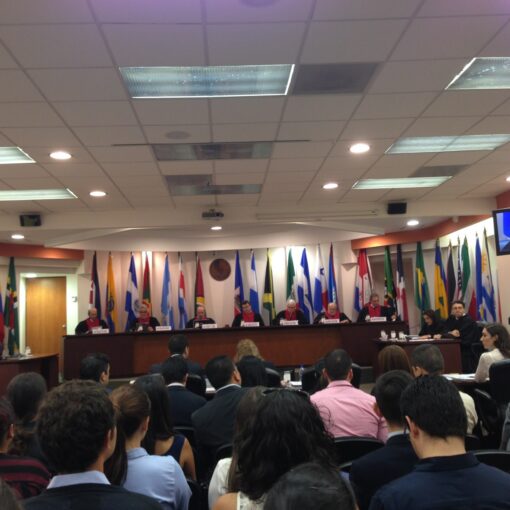 Under new leadership appointed by the Trump administration, federal agencies have weakened key regulations meant to protect the economy from the financial harms of climate change. Some of the targeted regulations seek to manage climate risk; others constrain corporate actions or investment strategies on a range of environmental, social, or governance (ESG) topics. A summary of notable rollbacks and relevant executive actions is provided below.
Under new leadership appointed by the Trump administration, federal agencies have weakened key regulations meant to protect the economy from the financial harms of climate change. Some of the targeted regulations seek to manage climate risk; others constrain corporate actions or investment strategies on a range of environmental, social, or governance (ESG) topics. A summary of notable rollbacks and relevant executive actions is provided below.
This post is part of a Climate Law Blog series reflecting on the first hundred days of President Trump’s second term across a variety of climate-related topics. Click here to read other posts from the series.
Federal Agency Rollbacks
Corporate Climate Risk Disclosure
Most notably, the Securities and Exchange Commission (SEC) will not defend its climate risk disclosure rule, the Enhancement and Standardization of Climate-Related Disclosures for Investors, in litigation brought by a coalition of business interests, oilfield service companies, and states challenging the rule. The rule, finalized in 2024 but stayed during the litigation, requires public companies to disclose information about their greenhouse gas (GHG) emissions and the financial risks they face from extreme weather events and the energy transition. In a March 27, 2025 letter, the SEC announced that it would withdraw its defense of the climate risk disclosure rule, though it did not initiate the typical agency process for rescinding a rule.
In its April 24, 2025 response to the SEC’s withdrawal, the Eighth Circuit granted intervenors’ motion to hold in abeyance litigation challenging the rule, and directed the SEC to clarify its position to the court within 90 days. The court seemed to agree with intervenors and the dissenting Commissioner that the proper route to rescind a rule is through affirmative use of the notice-and-comment rulemaking process, not through abandonment in the courts.
With the SEC’s climate disclosure rule currently stayed, two other domestic frameworks provide for climate risk and emissions disclosure: (1) California’s landmark climate disclosure laws, SB 253 and SB 261, both set to take effect on January 1, 2026; and (2) the Environmental Protection Agency’s (EPA’s) GHG Reporting Program. But the California laws already face litigation, and the EPA announced on March 12, 2025 that it would reconsider its GHG Reporting Program, which could drastically reduce the country’s ability to monitor and address the impacts of climate change.
Retreating on a similar regulatory effort in the waning days of the Biden Administration, the Federal Acquisition Regulatory Council (FAR Council) withdrew its proposed rule to require federal contractors to disclose and manage their GHG emissions, a reminder that even before the Trump administration took office, agencies were anticipating a reluctance to pursue certain robust regulations. Citing insufficient time to finalize the procurement rule, the council withdrew the proposal on January 13, 2025.
Initially published in November 2022, the FAR Council’s rule would have required certain contractors, depending on size, to disclose their Scope 1, Scope 2, and Scope 3 emissions, and to set emissions reduction targets. While its disclosure requirements paralleled other regulatory efforts, the proposed rule was notable for mandating emissions reduction efforts in line with climate science targets, a rare attempt by the federal government to require corporate GHG mitigation, rather than simply requiring disclosure of GHG emissions or climate-related financial risks.
Shareholder Engagement
The SEC revised its Guidance on the standard for whether a company must include a shareholder proposal for vote, essentially making it more difficult for investors to propose that public companies take action on a range of ESG issues, including climate.
Taking the unusual step of issuing guidance in the midst of the proxy “season,” the SEC rescinded Staff Legal Bulletin 14L (SLB 14L) on February 12, 2025, and reinstated previous Guidance issued during the first Trump administration, which provided more lenient standards for the exclusion of shareholder proposals under Rule 14a-8 of the Securities Exchange Act of 1934. The February 2025 Guidance pertains to “no action” requests, an informal process through which the SEC evaluates a security issuer’s claim that a shareholder proposal should be excluded from its proxy statement. The Guidance provides updated interpretations on a range of bases for exclusion, all of which generally tilt the analysis in favor of excluding shareholder proposals.
Historically, shareholder proposals have offered a key indicator of investor concern about ESG factors. SLB 14L’s rescission will likely to lead to an increased exclusion of shareholder proposals, including those that petition companies to disclose or take action on climate-related risks.
Investment Management
Forecasting the latest shift in a rule that has changed with every recent administration, the Department of Labor (DOL) may rescind the 2022 Investment Duties rule interpreting the fiduciary duty obligations of investment managers under the Employee Retirement Income Security Act of 1974 (ERISA). The DOL advised the Fifth Circuit on April 21, 2025 that it is considering revising the Investment Duties rule finalized during the Biden administration, which generally allows pension fund managers to consider the financial risks of ESG factors when making investment decisions, and authorizes consideration of collateral ESG benefits as a tiebreaker for two equally prudent investment options.
Judge Kacsmaryk in the Northern District of Texas had affirmed this rule in a decision on remand, following the Supreme Court’s Loper Bright opinion. His decision is currently on appeal, in Utah v. Chavez-DeRemer (5th Cir.). The Fifth Circuit paused the litigation on April 28, 2025, ordering the DOL to provide an update within 30 days as to whether it will repeal or maintain the rule.
Meanwhile, the SEC delayed compliance deadlines for its ESG Names rule. On March 14, 2025, the SEC announced a longer timeline for implementation of a September 2023 modification of the Names Rule adopted under the Investment Company Act, which requires companies to align funds’ investment strategies with characteristics in the fund name. Briefly, the rule requires that, if a fund name includes the words “growth” or “ESG,” the fund must invest at least 80% of its assets under management according to those goals.
A related rule, proposed by the SEC in June 2022, which would have required investment advisers and firms to disclose more about their ESG practices, was not finalized during the Biden administration and has little chance of moving forward now.
Banking Supervision
The Office of the Comptroller of the Currency (OCC) withdrew Guidance for how the nation’s largest banks should manage climate-related financial risk. On March 31, 2025, the OCC withdrew its participation in interagency principles for climate-related financial risk management for financial institutions with over $100 billion in total assets. The Board of Governors of the Federal Deposit Insurance Corporation (“FDIC”) and the Federal Reserve System (“Federal Reserve”) are expected to follow suit, undermining efforts to impose climate risk management processes through the banking sector’s supervisory process.
Several of the same agencies also withdrew from the Network of Central Banks and Supervisors for Greening the Financial System (NGFS), a global organization that seeks to identify and promote best practices to address climate risk in the financial sector. The Federal Reserve Board announced on January 17, 2025 its withdrawal from NGFS. The FDIC withdrew days later, as did the Federal Insurance Office. The OCC followed suit on February 11, 2025.
And finally, the OCC, FDIC, and the Federal Reserve Board announced on March 28, 2025 their intention to rescind a rule issued under the Community Reinvestment Act (CRA) in October 2023, and to reinstate the prior CRA framework established in 1995. The CRA was passed in 1977 to combat redlining and other forms of discrimination in lending. Advocates had sought a modernized CRA to address, among other concerns, climate resilience in communities that have long faced disproportionate exposure to environmental hazards. The 2023 final rule contained modest efforts to address climate change, including incentives for disaster preparedness, as well as weather-resiliency projects like flood control systems and infrastructure efforts to safeguard against rising sea levels. But the rule did not make decarbonization activities eligible for CRA credit, and failed to engage with the broader climate effects of bank financing.
White House Actions
Three Executive Orders and Memoranda issued by the second Trump administration are particularly relevant to the federal retreat on climate and financial regulation.
A February 18, 2025 Executive Order, entitled “Ensuring Accountability for All Agencies,” attempts to impose executive supervision over federal agencies that typically operate independently from the political process, including the Federal Reserve and the SEC. The implications of this Executive Order are significant for financial regulators, because those agencies have a particular need for independence. For example, if political leaders could demand that the Federal Reserve lower interest rates, that might generate immediate political advantages, but run contrary to the long-term national interest by increasing inflation, raising consumer prices, and reducing employment.
Relatedly, President Trump has threatened to remove the Federal Reserve Chair, Jerome Powell, despite the Fed’s legal independence. And the administration has already removed commissioners and board members from independent financial regulators, including firing the two Democratic commissioners of the Federal Trade Commission (FTC) and removing the two Democratic board members of the National Credit Union Association (NCUA).
An April 8, 2025 Executive Order, entitled “Protecting American Energy from State Overreach,” directs the Attorney General to identify state and local laws deemed to burden domestic energy resources (particularly state laws that address climate change), and to take action to stop the enforcement of those laws. The order singles out state climate laws the administration views as “illegal,” including climate superfund laws passed by New York and Vermont last year, as well as California’s cap-and-trade program. States’ pending legislation to require corporate emissions and climate risk disclosure will likely be targeted as well. The legal grounds for action pursuant to the April 8 Order are unclear, especially given the implications to principles of American federalism.
Finally, an April 9, 2025 Presidential Memorandum, entitled “Directing the Repeal of Unlawful Regulations,” instructs federal agencies to repeal regulations without undertaking the typical process for public notice required by the Administrative Procedure Act (APA). The APA does provide “good cause” exceptions to bypass the public notice-and-comment process for proposed regulations. But courts have interpreted these exceptions narrowly, allowing agencies to avoid public comment only under exigent circumstances (e.g. an emergency risk to the public; a minor and uncontroversial rule). The April 9 memo reinterprets those “good cause” exceptions to apply to any regulations an agency itself deems unlawful. This reading lacks a sound legal basis, and foreshadows an upcoming effort to evade transparency and public input as the administration withdraws more regulations.
The April 9 memo directs agencies to take steps immediately following a 60-day review period specified in a February 19, 2025 Executive Order (EO 14219). Meaning, the administration may be poised to further unwind financial regulations meant to safeguard the economy from climate-related financial risks, without sufficient public scrutiny.
Goalposts
This blog’s focus on regulatory retreat across the financial sector could imply that the prior framework was sufficient to manage the costs of climate change. It was not. For example, the climate disclosure rule that the SEC is now abandoning was already watered down, with “materiality” thresholds attached to most disclosure requirements and Scope 3 emissions disclosure removed from the final rule. (For analysis of the rule, see our previous blog series here). And even when major domestic banks were subject to the OCC’s climate risk management guidance, six of the world’s largest banks were unable to assess their exposure to climate risks like extreme weather and the clean energy transition.
Will regulatory efforts in other jurisdictions prove sufficient backstop? Legislators in states including Colorado, Illinois, New Jersey, and New York are attempting to require large companies to report GHG emissions, as California has done already. Several New York City pension funds recently announced climate planning standards for their asset managers. But these domestic efforts all face political headwinds, alongside indications of a global retreat on climate risk disclosure requirements. The International Sustainability Standards Board (ISSB) announced on April 28, 2025 a proposal to ease certain value chain emissions reporting requirements, and an Omnibus Regulation proposed in the European Union on February 26, 2025 may weaken EU sustainability rules. Meanwhile, large financial institutions have evaluated the current regulatory environment and determined they should plan for global warming conditions that far exceed safe scenarios, turning their attention to profit maximization through strategies like investing in the widespread proliferation of air conditioning.






